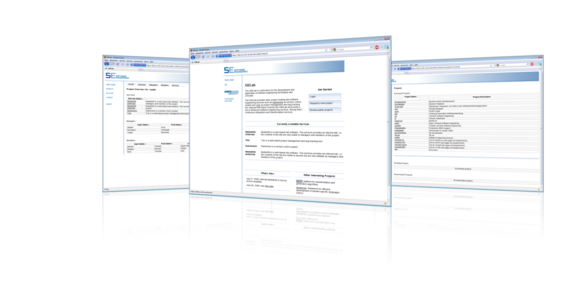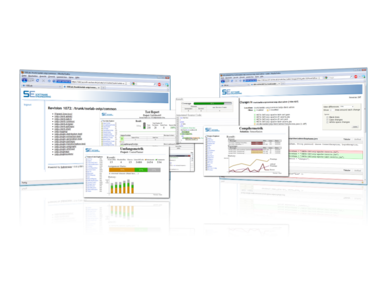
Main Page
From sselab
| Line 1: | Line 1: | ||
= SSELab = | = SSELab = | ||
| - | <gallery widths= | + | <gallery widths=600px heights=300px perrow=2> |
File:Sselab-bv.png | File:Sselab-bv.png | ||
| - | |||
File:Sselab-svn-trac-test.png | File:Sselab-svn-trac-test.png | ||
</gallery> | </gallery> | ||
| Line 16: | Line 15: | ||
The SSELab consists of several subsystems that offer different types of software engineering tools as services. A centralized enterprise application enables the efficient administration of users and projects, and basic services. Examples include tools for version control and the task, project and knowledge management. By another enterprise application, and related client applications, generation and transformation services, such as code generators for domain-specific languages (DSLs) or generating documentation are made available. A third subsystem realizes a flexible continuous integration environment through which the areas of quality assurance, testing and metrics management are covered. An essential aspect of all infrastructure components is the expansion of services offered at run time through the use of plug-in systems. | The SSELab consists of several subsystems that offer different types of software engineering tools as services. A centralized enterprise application enables the efficient administration of users and projects, and basic services. Examples include tools for version control and the task, project and knowledge management. By another enterprise application, and related client applications, generation and transformation services, such as code generators for domain-specific languages (DSLs) or generating documentation are made available. A third subsystem realizes a flexible continuous integration environment through which the areas of quality assurance, testing and metrics management are covered. An essential aspect of all infrastructure components is the expansion of services offered at run time through the use of plug-in systems. | ||
| - | + | The SSELab uses a variety of modern but at the same time industry-relevant technologies and frameworks for the development of server-based applications. Some examples are: | |
| - | + | ||
| - | + | ||
| - | + | ||
| - | * | + | * Languages and Frameworks: |
** Java Enterprise Edition (Java EE) 5: | ** Java Enterprise Edition (Java EE) 5: | ||
*** JBoss Rich Faces | *** JBoss Rich Faces | ||
| Line 28: | Line 24: | ||
*** Java Persistence API (JPA) | *** Java Persistence API (JPA) | ||
** OSGi | ** OSGi | ||
| - | * | + | * Test Frameworks: |
** JUnit | ** JUnit | ||
** DBUnit | ** DBUnit | ||
| Line 35: | Line 31: | ||
** Glassfish | ** Glassfish | ||
** JBoss Application Server | ** JBoss Application Server | ||
| - | * | + | * Database Systems: |
** PostgreSQL | ** PostgreSQL | ||
** MySQL | ** MySQL | ||
** SQLite | ** SQLite | ||
| - | + | Within the research project "Glose" (Global Software Engineering) in cooperation with the TU Clausthal, Leibniz University of Hanover, Munich Technical University and various industrial partners the SSELab expands to meet the specific needs of globally distributed development. | |
Revision as of 10:55, 31 January 2012
SSELab
The SSELab is a laboratory for the development and application of software engineering techniques and concepts.
A variety tools, frameworks and technologies for various tasks in the development process can be used for the efficient development of software. Particular at the beginning but also at run time a project, the installation, configuration and project-specific adaptation of these tools requires a high work-related and time-consuming effort.
The research project SSELab deals with the development of a centralized, server-based infrastructure, in which any kind of the software engineering tools can be integrated efficiently. This tools can be provided on demand for development projects and configured in accordance with the project-specific requirements.
Architecture and Technologies
The SSELab consists of several subsystems that offer different types of software engineering tools as services. A centralized enterprise application enables the efficient administration of users and projects, and basic services. Examples include tools for version control and the task, project and knowledge management. By another enterprise application, and related client applications, generation and transformation services, such as code generators for domain-specific languages (DSLs) or generating documentation are made available. A third subsystem realizes a flexible continuous integration environment through which the areas of quality assurance, testing and metrics management are covered. An essential aspect of all infrastructure components is the expansion of services offered at run time through the use of plug-in systems.
The SSELab uses a variety of modern but at the same time industry-relevant technologies and frameworks for the development of server-based applications. Some examples are:
- Languages and Frameworks:
- Java Enterprise Edition (Java EE) 5:
- JBoss Rich Faces
- Java Server Faces (JSF)
- Enterprise Java Beans (EJB) 3
- Java Persistence API (JPA)
- OSGi
- Java Enterprise Edition (Java EE) 5:
- Test Frameworks:
- JUnit
- DBUnit
- Server:
- Apache
- Glassfish
- JBoss Application Server
- Database Systems:
- PostgreSQL
- MySQL
- SQLite
Within the research project "Glose" (Global Software Engineering) in cooperation with the TU Clausthal, Leibniz University of Hanover, Munich Technical University and various industrial partners the SSELab expands to meet the specific needs of globally distributed development.

